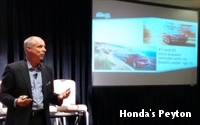
LOS ANGELES -- While TV is “still relevant” and continues to represent an important reach medium for national marketers, it is no longer sufficient for influencing consumers --
especially the kind of 20- and 30-somethings American Honda Motor Co. is looking to reach, Assistant Vice President-Marketing Tom Peyton asserted during a keynote opening OMMA Premium here this
morning. In its place, Peyton said, Honda is turning to music -- both live events and a multitude of digital distribution channels (even its own cars) -- to pick up the slack.
“It’s a big money play. It’s a bold play,” Peyton said of Honda’s pivot away from TV and toward music sponsorship and distribution, adding: “Frankly, we
think it’s not great that a company that makes cars is getting into the content business.”
advertisement
advertisement
That said, Peyton noted that Honda simply is working with the cards that have
been dealt to it, adding that it is using music as a means of leveraging “what the digital age has brought us.”
The concept, he said, began with the “Civic
Tour” in 2001 -- a series of live, experiential concert events sponsored by the Honda brand -- and has blossomed into the “Honda Stage,” which will feature 200 live performances
during the next year. He estimates those events will generate 2 billion media impressions, including 1 million live event-goers, and “tens o millions of earned and promotional views” via
social media.
Peyton described the strategy as a “TV replacement for us,” citing data indicating that only 34% of “Millennial” consumers watch “very
little or no TV today, and if they do, they watch it online.” He said that has increased from just 17% of the consumer segment a “few years ago.
“We said,
‘Geez, let’s get in the music business.”
Based on the success of the “Civic Tour,” Peyton said Honda jumped in with both feet, sponsoring or helping to
create “150 events just like it.”
The events are amortized in a variety of ways and media channels for Honda’s brands including its own -- including its Web site,
as well as its cars. The next generation of entertainment systems in Honda cars will enable consumers to access Honda Stage content like any other audio channel.
But the main
distribution driving Honda Stage are big digital music publishers including Clear Channel’s iHeartRadio, Live Nation, Vevo, Revolt and YouTube, the last of which he said currently is “the
largest distributor of music in the United States.”
“It was amazing to me when you see the gravitas that YouTube has now as a music channel,” Peyton said, noting
that YouTube currently generates about 50% of Honda Stage’s reach, compared to 33% for Pandora and only 23% or “TV music channels.”
“We think that is a potential
replacement for the reach and video access we had with TV previously,” he concluded.